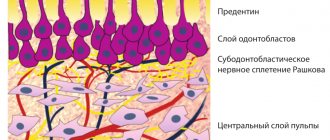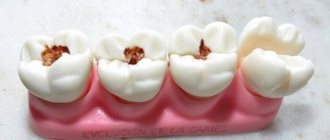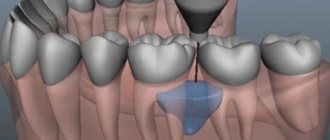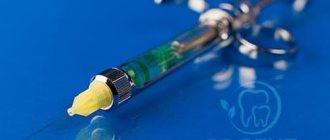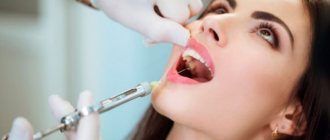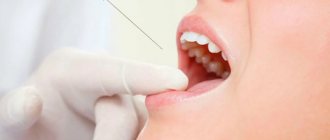Lidocaine spray - how effective it is for toothache
Toothache is one of the most severe and painful. In some cases, even pharmacy painkillers are not able to bring relief. Of course, you cannot tolerate such severe discomfort - you need to immediately run to the doctor. However, it is not always possible to promptly seek medical help, and then the only option to relieve acute toothache is to take painkillers. One of these drugs is Lidocaine. The product is available in various forms, including a spray for self-use. In general, this drug in dentistry is often used as an anesthetic before treatment, which indicates its unconditional effectiveness. Today we’ll talk about the effect of “Lidocaine” on teeth, its release forms, indications for use, and we will also provide simple and understandable instructions for using the spray.
Pain after tooth extraction
In some cases, effective treatment of advanced diseases involves the removal of a diseased tooth followed by prosthetics. After tooth extraction, pain, swelling and redness of the gums are a normal reaction of the body to tissue injury. You should be concerned if:
- the intensity of the pain does not decrease over time and is poorly removed by painkillers;
- the hole does not overgrow for a long time;
- purulent discharge appears from the wound;
- severe swelling of the mucous membrane occurs;
- body temperature rises.
The above symptoms indicate the development of an infectious process in the gum tissue. This happens if the tooth extraction technique is not followed or if the patient does not follow the doctor’s recommendations for oral care.
In what forms is the drug produced, components
Today, the drug is produced in 3 forms: in ampoules - an injection for the tooth, in the form of a gel with Lidocaine and a spray for the teeth. Further in this article we will concentrate on considering the spray, which is a colorless liquid, but with a pleasant menthol scent. The main active ingredient is the anesthetic of the same name - its concentration in a solution of 3.8 g (one bottle) is 4.8 mg. The composition of the drug also includes the following substances:
- propylene glycol,
- mint oil,
- ethanol solution – 96%.
A standard bottle holds approximately 650 doses. The kit includes a glass jar with a dispenser, a spray bottle and instructions for using the product.
How to cope with pain after dental treatment?
To feel comfortable after dental treatment, you must first take proper care of your oral cavity. The dentist must tell the patient in detail exactly how to carry out daily hygienic care of teeth and gums. After installing a filling or cleaning the canals, it is important not to put heavy stress on the treated tooth for some time. The following methods are also effective:
- Cold compress . Exposure to cold is good for eliminating swelling and dulling pain after invasive dental procedures. On the first day after treatment, you can apply cold compresses to the cheek in the area of pain. In order not to overcool the tissues, it is important to take a short break every 10-15 minutes.
- Baths with antiseptics or medicinal herbs . In some cases, it is recommended to take baths with antiseptic solutions several times a day to prevent infection and relieve pain.
- Taking medications . To improve your well-being in the first few days after dental treatment, you can take non-steroidal anti-inflammatory drugs that quickly and effectively relieve pain, swelling and other unpleasant symptoms. A safe remedy must be recommended by a doctor. Antibiotics after dental treatment are also prescribed exclusively by the attending physician.
If you follow all the doctor’s recommendations, the pain after tooth treatment will gradually decrease and completely disappear after a few days.
Pharmacology and pharmacokinetics - highlights
The active component of the spray effectively reduces the susceptibility of nerve endings, and this happens by blocking the conduction of the corresponding impulses. Acting systemically, the substance also provides an effect similar to that of antiarrhythmic drugs, but its use for therapeutic purposes does not in any way affect the functioning of the heart. If Lidocaine is sprayed near the respiratory tract, it also prevents coughing and gagging.
The drug also prevents coughing and vomiting.
The drug is quickly absorbed, and if a small amount of the drug enters the gastrointestinal tract, the active component is inactivated. The action occurs within 5-10 minutes. Metabilized in the liver by 90-95%.
In what cases is it used?
In dental practice, Lidocaine is used in various forms, including as a spray. The drug helps to anesthetize a limited area of the mucous membrane, and also promotes vasodilation without tissue irritation. Below are the main indications for use:
- for dental treatment in the presence of any dental diseases,
- for tooth extraction,
- for problematic teething,
- with stomatitis,
- as part of professional cleaning and removal of deposits,
- before opening cystic neoplasms.
The drug is usually administered by injection.
To eliminate sensitivity before treatment, the drug is usually administered by injection. In the form of a spray, it is sometimes applied before an anesthetic injection. Many people are interested in how long dental anesthesia lasts and wears off. Usually the effect occurs within 5 minutes, lasts for 1-2 hours, after which sensitivity is restored. Therefore, it is not recommended to eat for some time after treatment, since you can accidentally injure your tongue. The spray is also widely used for toothache at home.
Main causes
Dental treatment can be therapeutic or surgical, and pain can appear after any type of intervention. In most cases, mild or moderate pain is a physiological reaction of tissues to the manipulation, can be easily eliminated by taking anti-inflammatory or painkillers and lasts several days after a visit to the dentist.
Also, pain after dental treatment appears due to complications and violations of the technique of performing medical manipulations. Pain is most often observed after:
- dental fillings;
- root canal treatment;
- removal of a diseased tooth, cyst or granuloma.
The dentist must advise the patient about how the recovery process will occur after treatment and for what symptoms it is necessary to come for another appointment. Also, for comfortable well-being after treatment, anti-inflammatory and, in some cases, antibacterial drugs are prescribed. If, despite following all the doctor’s recommendations, the pain continues to bother you, then it is best to undergo another examination by a specialist.
In what situations is Lidocaine in spray form contraindicated?
There is a list of contraindications to the use of the anesthetic in question. Such pathological phenomena include the following conditions:
- intolerance to the active substance,
- allergy to anesthetic,
- if the patient has had seizures in the past as a result of taking any form of lidocaine,
- frequent fainting,
- bradycardia,
- weak sinus node
- some pathologies of the heart and blood vessels.
The drug is not used when taking impressions of teeth.
Also, the spray is not used when taking impressions of teeth - the risk of penetration of the material into the respiratory system is too great. Before using the product, the specialist must make sure that the patient has no contraindications.
Types of pain
There are different types of pain.
Experts divide all pain into two categories:
- acute, appears suddenly, usually due to injury, does not last long;
- chronic, lasts a long time, occurs as a result of chronic inflammation.
When taking medications for pain, you should consider the type of pain. In some cases, it is prohibited to use painkillers. For example, with acute abdominal pain. This way the disease can be veiled, as a result doctors will not be able to accurately diagnose the disease.
Instructions and dosage
Lidocaine spray is intended for spraying onto the mucous surface in the problem area where sensitivity needs to be blocked. Let's figure out how to use it correctly and how to use Lidocaine to numb a tooth. The scheme here is very simple: before applying the drug, the bottle needs to be shaken thoroughly, while holding it strictly vertically. 3-5 sprays are enough to provide the required degree of anesthesia and prevent the absorption of too high concentrations of substances into the blood.
If we are talking about anesthetizing an area of the oral mucosa in a child, then we should do it differently. To begin with, the product must be sprayed onto a small piece of gauze, which must then be applied to the affected area. This method of applying the product is used so as not to inadvertently scare the baby, and also not to provoke a burning sensation in his mouth. For patients suffering from impaired liver and kidney function, the dosage should be reduced by at least 40%1.
Possible side effects
We figured out how to use Lidocaine spray, and now we’ll find out what side effects the drug can cause. So, after applying the product, the patient may experience local negative reactions such as burning, redness of the mucous membrane or skin. As a rule, such manifestations disappear on their own immediately after the onset of the analgesic effect. There is also a risk of developing allergies, which can manifest as itching and rashes. In extremely rare situations, anaphylactic shock occurs.
Some anxiety is likely to appear as a reaction of the nervous system. In some cases, the drug leads to a decrease in heart rate or blood pressure. To decide whether it is possible to use Lidocaine anesthesia for dental anesthesia in relation to a particular patient, the doctor must first make sure that he has no contraindications to the use of the drug.
Additional instructions for use
Before spraying the spray on the mucous membrane, you need to carefully study the instructions that come with the kit. There are several special points to consider when using Lidocaine. Let's take a closer look at them.
During pregnancy and lactation
The drug is allowed for use in therapeutic doses during pregnancy. However, you should consult your doctor before using it. As for the lactation period, in this case it is better to wait to use the drug while the child is breastfed.
Use during pregnancy should be agreed with your doctor.
Read more about dental treatment during pregnancy in our special article>>>
Use in childhood
Lidocaine in the form of a spray is approved for children, but there are some nuances here. So, for example, it is recommended to apply the drug to children under the age of 2 years in a special way: first, the product needs to be sprayed onto a small gauze pad, and then applied to the area of pain. It should be taken into account that in childhood the swallowing reflex occurs more often than in adults, therefore it is not recommended to spray the anesthetic directly.
This is what an allergy to lidocaine looks like in a child
“The doctor prescribed Lidocaine for us after we had a baby tooth with gumboil removed. He said to apply it on cotton wool and apply it to the swollen gum so that it doesn’t hurt too much. We used it for just a couple of days, everything healed quickly, and the child did not complain of pain. Of course, you’d better consult your doctor about this, but in general I know for sure that the spray can be used for children...”
Irina V., Penza, from correspondence on the woman.ru forum
For liver problems
The drug should be used with extreme caution by people suffering from renal and liver failure. As mentioned above, the therapeutic dosage in this case should be reduced by at least 40%. In addition, in such a situation, using the spray without prior approval from a doctor is strictly contraindicated. This restriction also applies to patients with arterial hypertension and epilepsy.
In old age
Elderly people should also be careful with the anesthetic. The spray cannot be used without a doctor's prescription. There is a possibility that the active ingredient will have a negative effect on the cardiovascular system, so before using the drug you should make sure that the patient does not have any heart problems.
In old age, the drug should be used with caution
Lidocaine may react with other medications, which also needs to be taken into account. However, it does not affect the functioning of the central nervous system, therefore it does not impose any restrictions on activities that require increased concentration.
Pain after dental filling
Dental filling is the most frequently performed treatment procedure in any dental clinic. Due to the high prevalence of caries, each dentist installs several fillings per day. However, even such routine dental manipulation in some cases leads to complications and pain in the patient after treatment.
Slight pain when putting pressure on a filled tooth normally goes away a few days after the filling is installed. To reduce discomfort, you can take anti-inflammatory medications as prescribed by your doctor. But if the pain does not go away and intensifies over time, then this may indicate a complication after dental filling. The main causes of pain are:
- Improper grinding of the filling . Grinding is one of the final stages of tooth restoration using filling materials. This procedure is performed to make the filling smooth and consistent with the patient's bite. If the dentist incorrectly polished the filling and it remains too high, this leads to improper closure of the jaws and injury to the mucous membrane. Also, an unsuitable filling increases the sensitivity of teeth to various irritants (exposure to cold, sour or sweet foods). In such cases, you need to contact your dentist again so that he can adjust the height of the filling and the associated discomfort will no longer bother you.
- Allergy to filling materials . Materials for filling teeth are being improved every year, but the use of even the most modern filling materials cannot completely eliminate the occurrence of an allergic reaction. Symptoms of individual intolerance include swelling, pain, redness of the gums, and a strange taste in the mouth. It is important to understand that similar symptoms occur if you are allergic to a local anesthetic drug. If you suspect that you are allergic to a temporary or permanent filling, you should immediately contact a dental clinic, where the placed filling will be removed from the tooth and filled with other materials.
- Violation of filling technique . Pain after dental treatment sometimes appears if the dentist performed one of the filling stages incorrectly. Pain may occur due to overheating of dentin when preparing a carious cavity with a drill, which leads to inflammation of the pulp. Pain also appears if a special acid is applied for a long time, which improves the fixation of the filling on the tooth, or if the drying technology is disrupted. Any mistake when installing a filling can lead to increased tooth sensitivity and pain. The method for correcting complications is selected individually.
- Development of secondary caries . In some cases, an infectious process can develop under a previously installed filling. This occurs due to insufficient treatment of the carious cavity before installing the filling, as well as due to the loose fit of the filling to the natural tissues of the tooth. The danger of this process is that it is more difficult to visually notice secondary caries. Signs of pathology are darkening of the enamel and pain in the tooth affected by caries. In such cases, the dentist removes the old filling and re-treats the caries.
- Incorrect diagnosis . Pain after filling teeth occurs in cases where the dentist missed the presence of pulpitis in the patient and did not check the condition of the root canals of the tooth. Moreover, even after a high-quality filling is installed, complaints may remain of aching, intense pain of a bursting nature, which intensifies with chewing and biting. To prevent further spread of the inflammatory process, cleaning and treatment of the root canals and removal of the nerve are required. After these manipulations, the canals are filled and the tooth is restored.
To avoid complications and pain after dental filling, a thorough preliminary examination and treatment using high-quality materials by an experienced dentist is necessary. If you experience severe pain after installing a filling, you should immediately contact your doctor.
How to dispense in pharmacies and storage rules
The drug can be used for 5 years from the date of release. The bottle should be kept in a place protected from direct sunlight, where children cannot get into. Recommended storage temperature varies between 15-25 degrees above zero. The estimated cost of the drug in Moscow ranges from 350 to 380 rubles. "Lidocaine" is dispensed only with a prescription from a doctor, which excludes the possibility of its independent use without prior consultation with a specialist.
How can you replace Lidocaine spray?
Many people are interested in whether there are analogues of Lidocaine and how it can be replaced. In fact, there are quite a lot of drugs with similar effects, but it is difficult to answer the question of which is better than the drug in question. “Lidocaine” is rightfully considered one of the most effective and proven anesthetics, and that is why dentists most often prefer it.
As an alternative, you can consider drugs such as Lidocaine Vial or Xylocaine. Both are available in the form of a spray for external use and are characterized by a rapid onset of effect, as well as a relatively long-lasting and sustainable effect. You can also pay attention to similar drugs in gel form - “Xycain” and “Xylocain”. Remember: you can start taking any medications only after the attending physician gives his consent. Otherwise, there is a risk of causing serious complications.

